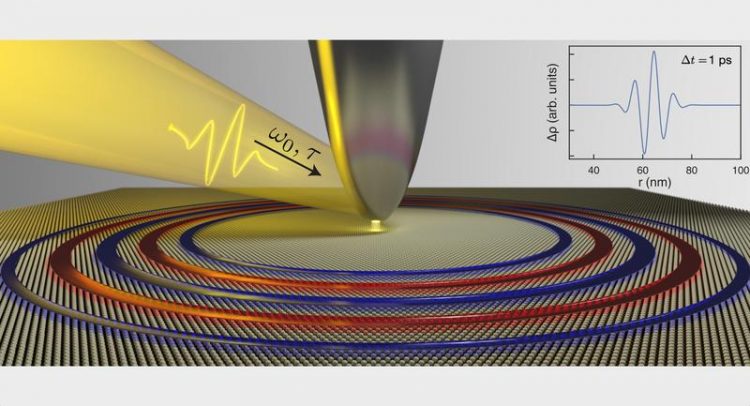When plasmons reach atomic flatland

A slowly moving plasmon wave packet excited on monolayer TaS₂. The wave packet is highly localised in real space even at ~1 ps after its creation with an ultrafast laser pulse and an atomic-for Felipe da Jornada
Almost seventy years ago, scientists showed that electrons in materials could sustain wavelike propagating oscillations, known as plasmons. Nowadays, there is a vibrant field of plasmonics which studies these electronic oscillations, with applications such as faster computer chips, solar cells, biosensors, and even cancer treatments.
Plasmons are strongly affected by the geometry of their host materials, which makes them very tunable for different applications. However, it was not clear how plasmons behave in an extreme case: when materials are just a couple of atoms thick.
The international research team consisting of Felipe da Jornada and Steven Louie from the LBNL at the University of California, Berkeley, and Lede Xian and Ángel Rubio from the MPSD, which is based at the Center for Free-Electron Laser Science (CFEL), wanted to shed new light on the properties of plasmons in these novel atomically thin materials.
Using parameter-free quantum calculations, they found that plasmons behave in a peculiar way in all atomically thin materials. This was initially a surprise to the authors: “Textbook physics says that plasmons in bulk materials behave in one way, and in strictly two-dimensional materials, in another way. But unlike these simplified models, plasmons in all real, atomically thin materials behave yet differently and tend to be much more localizable in space,” says Felipe Jornada, who is now based at Stanford University.
The reason for this difference, Steven Louie argues, is that “in real atomically thin materials, all the other electrons that are not conducting and oscillating can screen these plasmons, which leads to a fundamentally different dispersion relations for these excitations.”
Other key findings of their research are that the plasmons in systems such as monolayer TaS2 can remain stable for long times (~ 2 ps) and are virtually dispersionless for wavevectors which are commonly used in certain experiments.
This indicates that plasmons in atomically thin materials are localizable in real space with available experimental techniques and could significantly enhance the intensity of light by a factor of more than 10⁷.
Ángel Rubio, the director of the MPSD’s Theory Department, says: “These findings are relevant for many applications, from promoting photocatalytic reactions to biosensing and single-molecule spectroscopy.”
Prof. Felipe da Jornada, lead author: jornada@stanford.edu
Dr. Lede Xian, co-author: lede.xian@mpsd.mpg.de
Media Contact
All latest news from the category: Information Technology
Here you can find a summary of innovations in the fields of information and data processing and up-to-date developments on IT equipment and hardware.
This area covers topics such as IT services, IT architectures, IT management and telecommunications.
Newest articles

NASA: Mystery of life’s handedness deepens
The mystery of why life uses molecules with specific orientations has deepened with a NASA-funded discovery that RNA — a key molecule thought to have potentially held the instructions for…

What are the effects of historic lithium mining on water quality?
Study reveals low levels of common contaminants but high levels of other elements in waters associated with an abandoned lithium mine. Lithium ore and mining waste from a historic lithium…

Quantum-inspired design boosts efficiency of heat-to-electricity conversion
Rice engineers take unconventional route to improving thermophotovoltaic systems. Researchers at Rice University have found a new way to improve a key element of thermophotovoltaic (TPV) systems, which convert heat…



